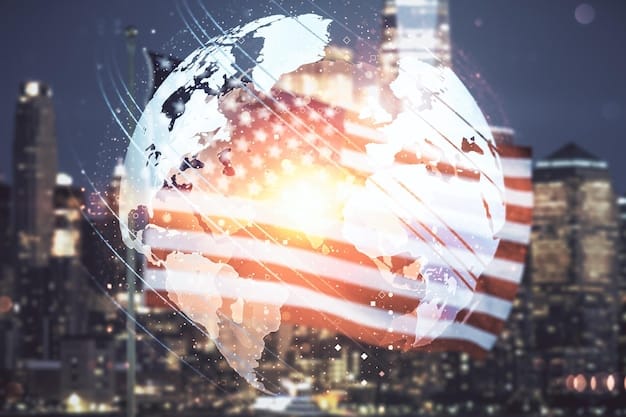Critical Update: US Export Regulation Changes in Q2 2025

Critical Update: Changes to Export Regulations Affecting US Companies in Q2 2025 signifies upcoming shifts in US export laws, potentially impacting international trade strategies for US businesses, necessitating a comprehensive understanding and adaptation to maintain compliance and competitiveness.
The landscape of international trade is constantly evolving, and U.S. companies engaged in exporting need to stay informed of regulatory changes. This article provides a critical update: changes to export regulations affecting US companies in Q2 2025, outlining what you need to know to maintain compliance and avoid potential penalties.
Understanding the Export Administration Regulations (EAR)
The Export Administration Regulations (EAR) are a set of regulations administered by the Bureau of Industry and Security (BIS) under the U.S. Department of Commerce. They control the export and reexport of most commercial items, often referred to as “dual-use” items, which have both commercial and military applications. A thorough understanding of the EAR is crucial for any U.S. company involved in exporting goods, software, or technology.
These regulations are designed to safeguard national security interests, prevent the proliferation of weapons of mass destruction, and promote U.S. foreign policy objectives. Failing to comply with the EAR can result in severe penalties, including fines, imprisonment, and loss of export privileges. Staying updated with any changes to the EAR is not just good practice; it’s a legal necessity.
Key Components of the EAR
The EAR is complex, but some key components include the Commerce Control List (CCL), which categorizes items subject to export controls, and the Export Control Classification Number (ECCN), which identifies specific items on the CCL. Understanding these classifications and controls is essential for determining whether an export license is required.
Recent Amendments and Their Impact
Amendments to the EAR are frequently issued to address emerging security threats, technological advancements, and geopolitical shifts. These amendments can impact a wide range of industries, from aerospace and defense to telecommunications and semiconductors. Therefore, ongoing monitoring and assessment of these changes are crucial.
- Staying informed about changes to the CCL and ECCNs.
- Understanding the latest licensing requirements for specific items and destinations.
- Implementing robust export compliance programs to mitigate risks.
In conclusion, the Export Administration Regulations (EAR) are a critical aspect of international trade for U.S. companies. Understanding their purpose, key components, and recent amendments is vital for maintaining compliance and avoiding potential penalties, thereby ensuring smooth and secure global trade operations.
Q2 2025 Regulatory Changes: Overview
In the second quarter of 2025, a series of significant changes to U.S. export regulations are set to take effect. These changes will impact various industries and require U.S. companies to re-evaluate their export compliance programs. Understanding the specifics of these regulatory shifts is pivotal for ensuring seamless international trade operations.
These new regulations touch on several key areas, including enhanced controls on emerging technologies, stricter enforcement of existing rules, and adjustments to licensing requirements for certain destinations. Businesses must adapt swiftly to these changes to remain competitive and compliant in the global market.

Specific Areas Affected
The Q2 2025 regulatory changes will particularly affect sectors dealing with artificial intelligence, quantum computing, and advanced materials. These technologies are now subject to more stringent export controls due to their potential military applications and national security implications.
Geographical Impacts
Certain countries will face increased scrutiny regarding exports, with a focus on preventing the diversion of sensitive technologies. Companies exporting to these regions must conduct thorough due diligence to ensure compliance with the updated regulations.
- Reviewing current export control procedures for compliance with the new regulations.
- Conducting risk assessments to identify potential vulnerabilities in export operations.
- Providing additional training to employees on the updated regulatory requirements.
In summary, the Q2 2025 regulatory changes introduce critical shifts in U.S. export regulations, particularly affecting emerging technologies and specific geographical regions. U.S. companies must proactively adapt to these changes by reviewing compliance procedures, conducting risk assessments, and providing employee training to ensure seamless international trade operations.
Impact on Key Industries
The forthcoming updates to export regulations in Q2 2025 will have a significant ripple effect across various sectors, requiring businesses to adapt and realign their strategies. Key industries such as Technology and Manufacturing need to prepare for specific challenges and opportunities that these regulatory shifts present.
These regulatory changes can potentially disrupt supply chains, increase compliance costs, and alter competitive landscapes. Businesses that proactively understand and adapt to these changes will be better positioned to succeed in the evolving global market. Preparing for the upcoming changes is critical for maintaining competitiveness and ensuring continued growth.
Technology Sector
The technology sector will face stricter controls on the export of advanced technologies, including AI, quantum computing, and semiconductors. This may require companies to shift their R&D efforts and explore alternative markets.
Manufacturing Sector
Manufacturers will need to carefully review their supply chains to ensure compliance with the new regulations. This could involve diversifying suppliers, implementing enhanced tracking systems, and obtaining necessary export licenses.
- Reassessing international market strategies to align with regulatory changes.
- Investing in compliance technologies to streamline export processes.
- Enhancing collaboration with regulatory agencies to stay ahead of compliance requirements.
In conclusion, the export regulation updates in Q2 2025 will significantly impact sectors like Technology and Manufacturing. Proactive adaptation through reassessing strategies, investing in compliance technologies, and enhancing agency collaboration is crucial for maintaining competitiveness and navigating the evolving global market landscape.
Steps US Companies Should Take Now
Preparing for the Q2 2025 export regulation changes requires a proactive and comprehensive approach. U.S. companies must take immediate steps to assess their current export practices, implement necessary adjustments, and ensure compliance with the upcoming regulations. Ignoring these steps could lead to significant operational and financial repercussions.
By taking these preparatory steps, companies can reduce risk, improve efficiency, and maintain a competitive edge. Action now ensures readiness and minimizes disruption when the changes take effect. Having a robust response plan is critical to a smooth transition into the revised regulatory setting.

Conduct a Compliance Audit
The first step is to conduct a thorough audit of current export compliance programs. This audit should identify any gaps or weaknesses that need to be addressed to align with the new regulations.
Enhance Training Programs
Provide additional training to employees involved in export activities. This training should cover the specifics of the Q2 2025 regulatory changes and their implications for the company’s operations.
- Engaging legal experts to provide guidance on compliance requirements.
- Implementing advanced tracking systems to monitor export activities.
- Establishing clear communication channels with regulatory agencies for updates and clarifications.
To summarize, preparing for the Q2 2025 export regulation changes involves immediate actions such as conducting compliance audits and enhancing training programs. Engaging legal experts, implementing advanced tracking systems, and establishing clear communication channels with regulatory agencies are also crucial for a smooth transition and sustained compliance.
Leveraging Technology for Compliance
In an increasingly complex regulatory environment, technology plays a pivotal role in streamlining export compliance processes. U.S. companies can leverage various technological solutions to manage export controls more efficiently, reduce errors, and enhance overall compliance. Embracing the right technologies is critical for navigating the intricacies of modern trade regulations.
Automated systems, data analytics, and secure communication platforms enable businesses to stay ahead of regulatory changes and adapt proactively. Investing in technology can lead to significant improvements in compliance outcomes and operational efficiency. Utilizing technology offers a strategic advantage when it comes to handling global trade requirements.
Automated Export Control Systems
Automated systems facilitate the screening of export transactions against restricted party lists, reducing the risk of inadvertent violations. These systems can also automate the generation of export documentation and track shipments in real-time.
Data Analytics and Reporting
Data analytics tools can help companies identify patterns and trends in their export data, enabling them to proactively address potential compliance issues. These tools can also generate reports for internal and external stakeholders.
- Implementing blockchain technology for secure and transparent supply chain management.
- Using AI-powered tools for risk assessment and compliance monitoring.
- Adopting cloud-based solutions for accessible and collaborative compliance management.
In conclusion, leveraging technology through automation and data analytics is crucial for streamlining export compliance. Implementing blockchain, AI, and cloud-based solutions further enhances supply chain management, risk assessment, and collaborative compliance, providing a technological edge in navigating global trade regulations.
Seeking Expert Guidance and Resources
Navigating the complexities of U.S. export regulations can be challenging, and seeking expert guidance is often necessary. U.S. companies can benefit from consulting with legal experts, industry associations, and government agencies to ensure compliance and optimize their export strategies. Access to expert knowledge and resources is pivotal for sound decision-making and robust risk management.
Engaging with these resources provides companies with the latest insights, best practices, and practical advice for adapting to regulatory changes. Collaboration with these entities helps to solidify an understanding of compliance requirements and overall international trade effectiveness. Leveraging expertise ensures that businesses are well-informed and equipped to handle the demands of global commerce.
Legal Expertise
Consult with legal experts specializing in export controls to interpret the regulations and develop customized compliance programs. These experts can provide tailored advice based on your company’s specific circumstances and industry.
Industry Associations
Join industry associations that provide resources and advocacy related to export regulations. These associations often conduct training sessions, publish compliance guides, and represent the interests of their members before regulatory agencies.
- Utilizing government resources, such as the Bureau of Industry and Security (BIS).
- Attending trade conferences and seminars for industry updates.
- Participating in peer-to-peer learning through industry networks.
In summary, expert guidance is crucial in navigating U.S. export regulations. Legal expertise aids in interpreting regulations, industry associations provide valuable resources and advocacy, while government resources, trade conferences, and peer networks enhance understanding and adaptation to industry changes.
| Key Point | Brief Description |
|---|---|
| 📝 Regulatory Changes | Updates to EAR impacting Technology & Manufacturing |
| 🌍 Geographical Impact | Increased scrutiny on exports to specific countries to prevent technology diversion. |
| ✅ Compliance Steps | Conduct audits, enhance training, and engage legal experts. |
| 🚀 Tech Solutions | Leverage automation and data analytics for efficient compliance. |
Frequently Asked Questions
▼
The Export Administration Regulations (EAR) are regulations administered by the Bureau of Industry and Security (BIS). They control the export and reexport of most commercial items that have both commercial and military applications.
▼
The key industries affected include technology, particularly in areas such as AI and quantum computing, and manufacturing, especially those involved in the supply chain.
▼
US companies should conduct compliance audits, enhance employee training, engage legal experts, and implement advanced tracking systems to monitor export activities.
▼
Technology tools such as automated export control systems and data analytics tools can streamline compliance processes, reduce the risk of violations, and improve overall efficiency.
▼
US companies can seek expert guidance from legal experts specializing in export controls, industry associations providing resources and advocacy, and government agencies like the Bureau of Industry and Security (BIS).
Conclusion
Staying ahead of export regulation changes is vital for U.S. companies to remain competitive and compliant within the global market. The Q2 2025 updates to U.S. export regulations, particularly those affecting emerging technologies and specific geographic regions, require a proactive and informed approach. By taking immediate steps to assess current export practices, implement necessary adjustments, and seek expert guidance, organizations can navigate these changes effectively and sustain long-term success. Ensuring due diligence and maintaining open communication channels with regulatory agencies will further support a seamless transition.





